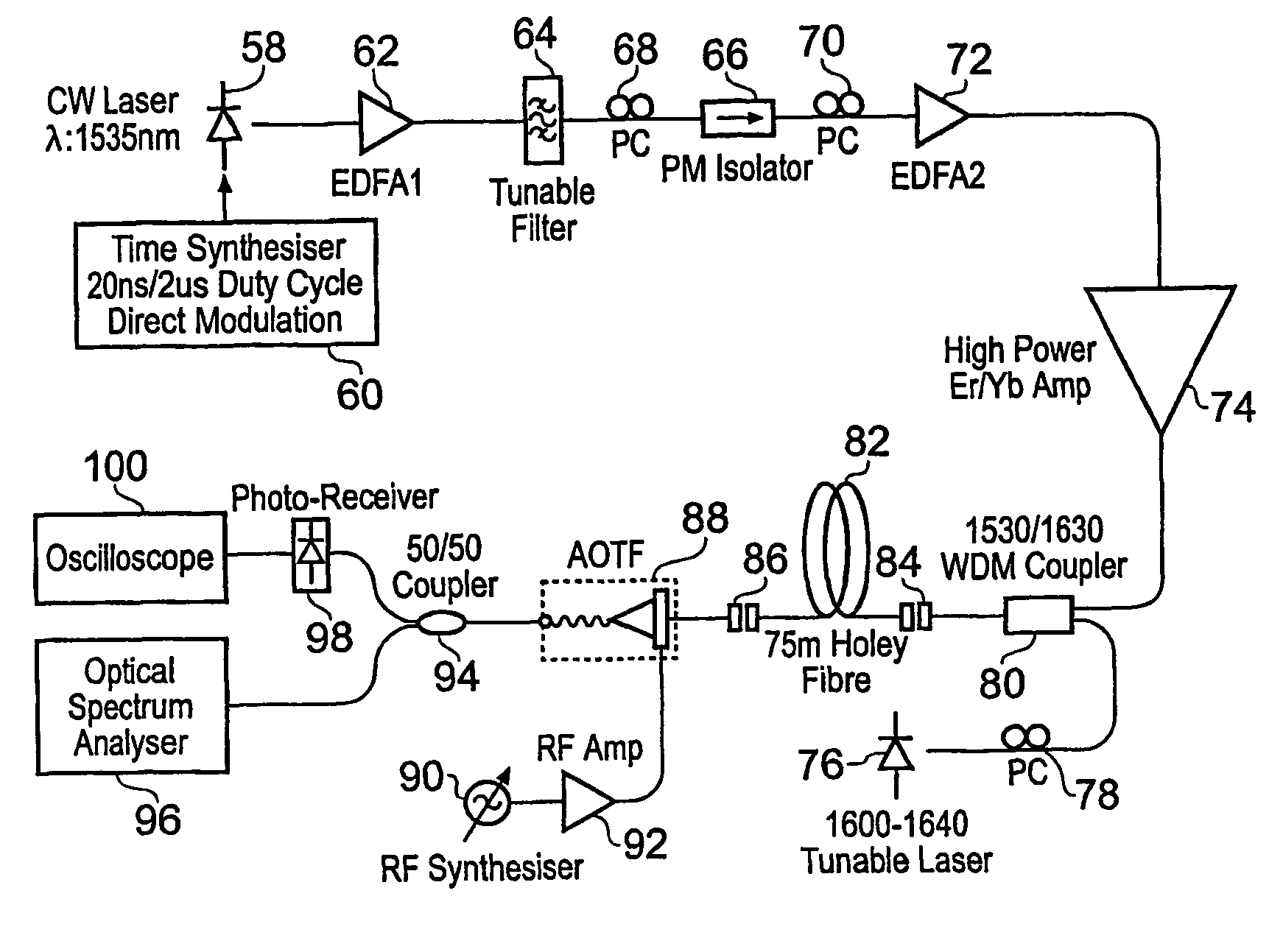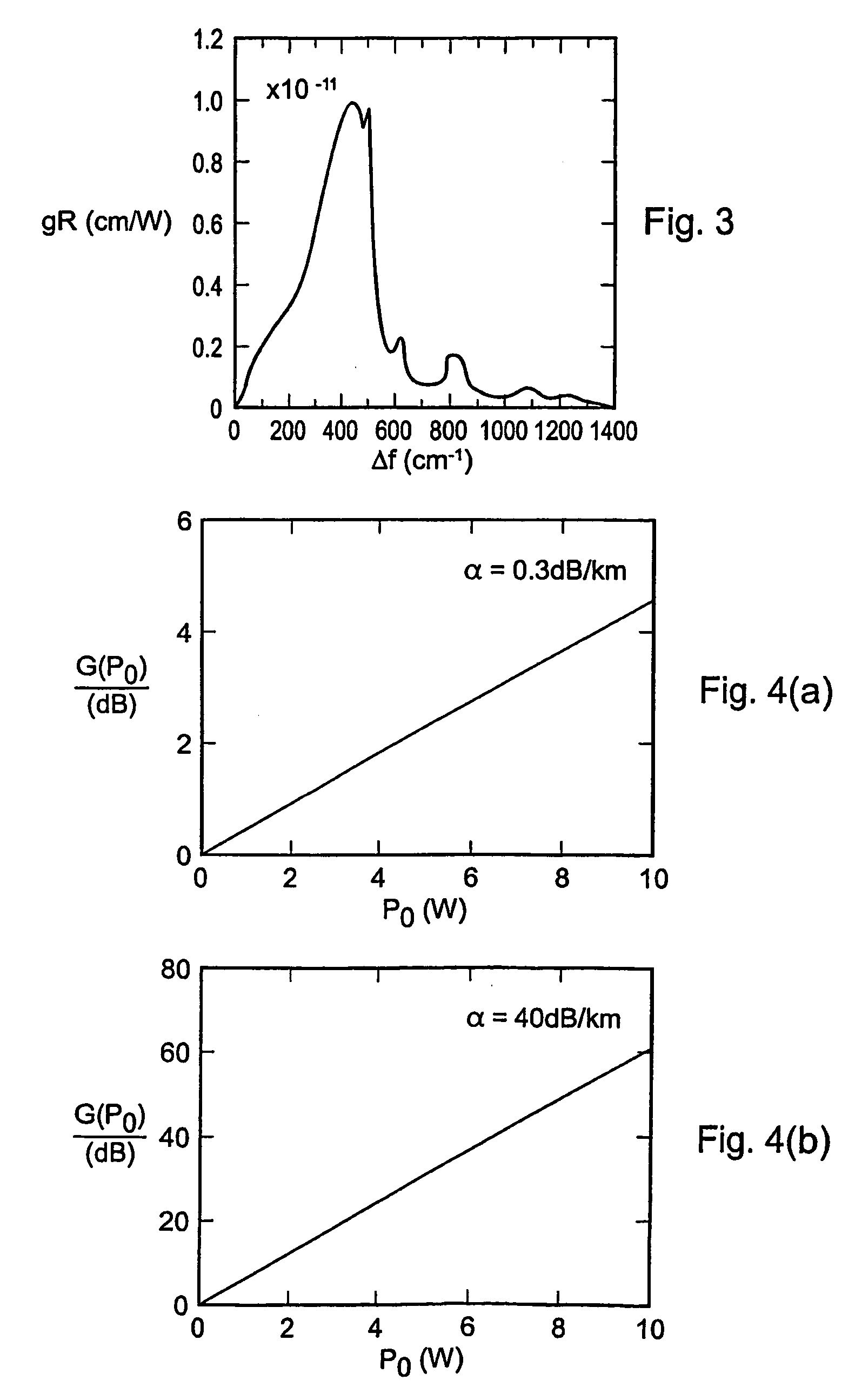Optical fibre-based devices utilising the Raman effect
a technology of optical fibre and raman, which is applied in the direction of fiber transmission, lasers, transmission, etc., can solve the problems of interference with co-propagating signals, major loss and noise, and the length of fibre required in standard fibre raman devices is rayleigh back-scatter, so as to increase the nonlinearity of holey fibres and increase the raman gain. , the effect of increasing the power handling capability
- Summary
- Abstract
- Description
- Claims
- Application Information
AI Technical Summary
Benefits of technology
Problems solved by technology
Method used
Image
Examples
first embodiment
[0115]FIG. 12 shows a schematic diagram of an experimental setup used to implement a Raman amplifier using holey fibre in accordance with a first embodiment of the present invention. A co-propagation scheme of pump and signal was adopted (in which the pump wave and the signal, or probe, wave are launched into the same end of the holey fibre) so as to avoid difficulties of having to maximise the launching of light into the holey fibre at both of its ends.
[0116]A pump optical source 58 is used to provide pump light. The pump optical source 58 is a quasi-cw pulsed source capable of generating 20 ns square pulses of 500 kHz, by use of an associated time synthesiser 60 to modulate the output of a semiconductor laser. This arrangement gives watts of peak power, which is sufficient to obtain an appreciable level of gain. The use of such short pulses, having a 500 ps rise time, broadens the spectral bandwidth of the pump pulses, which helps to minimise the unwanted effect of stimulated Bril...
second embodiment
[0129]As discussed in the Theoretical Background section, the Raman effect can provide optical loss, as well as optical gain [3, 12]. This can be used to modulate an optical signal, whereby the pattern of a modulated pump wave is imprinted “negatively” onto a cw signal wave at a shorter wavelength and weaker power; “holes” are effectively made in the signal wave by the loss induced by the pump wave. Using holey fibre as the Raman medium in such a device confers the same benefits as are obtained by using a holey fibre in a Raman amplifier, such as a much reduced fibre length to produce a similar effect compared to a device based on standard fibre.
[0130]FIG. 18 shows a schematic diagram of an experimental arrangement used to provide an optical modulator based on the Raman effect in a holey fibre according to a second embodiment of the invention. The components are the same as those used for the Raman amplifier described in the first embodiment, with reference to FIG. 13, except that t...
third embodiment
[0141]The benefits of using a holey fibre as a Raman medium can be further exploited by using holey fibre as the gain medium in a Raman laser. In a Raman laser, the gain derives from stimulated Raman scattering, as described above with respect to the Raman amplifier, and the output signal at the Stokes wavelength derives initially from the first scattering events producing photons at the Stokes wavelength. It is further increased by the provision of optical feedback to provide multiple passes through the Raman gain medium so that the Stokes wave experiences the Raman gain, is amplified, and lases. Thus, as for conventional fibre amplifiers and lasers, a Raman fibre laser differs from a Raman fibre amplifier by including a feedback arrangement and not having an optical source at the output wavelength.
[0142]FIG. 22(a) shows a possible configuration for a Raman fibre laser based on a holey fibre. The laser is arranged as a bulk device in a Fabry-Perot configuration. A pump source 112 p...
PUM
| Property | Measurement | Unit |
|---|---|---|
| length | aaaaa | aaaaa |
| length | aaaaa | aaaaa |
| length | aaaaa | aaaaa |
Abstract
Description
Claims
Application Information
 Login to View More
Login to View More - R&D
- Intellectual Property
- Life Sciences
- Materials
- Tech Scout
- Unparalleled Data Quality
- Higher Quality Content
- 60% Fewer Hallucinations
Browse by: Latest US Patents, China's latest patents, Technical Efficacy Thesaurus, Application Domain, Technology Topic, Popular Technical Reports.
© 2025 PatSnap. All rights reserved.Legal|Privacy policy|Modern Slavery Act Transparency Statement|Sitemap|About US| Contact US: help@patsnap.com



